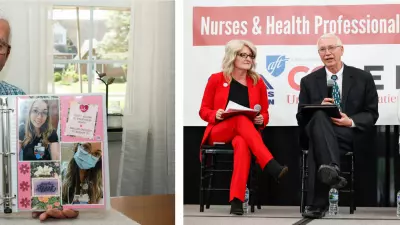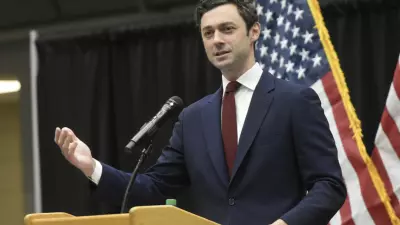This story deals with suicide. If you need help, you can call 988 to speak with a trained listener, or visit 988lifeline.org for crisis chat services and more information.

Tristin Kate Smith knew she wanted to be a nurse in high school. She enrolled in a state tested nurse aide, or STNA, program and was soon working at a nearby retirement home. From there, she went to school and got licensed as a registered nurse.
And she was really good at it. Her sisters, Daye and Sarah Smith, say Tristin had a knack for making people comfortable and getting them to open up.
“She was very aware, socially aware of other people and their comfort levels,” Sarah said. “She would always try to make you just be okay to talk to her.”
“I think that’s what made her a really good nurse,” Daye added.
But for all her aptitude and training, Tristin’s family says nursing demanded too much of her. In August of last year she died by suicide, leaving behind a family struggling to make sense of what could’ve happened to their daughter and sister.
“It’s hard to know what was going through her mind,” her father Ron Smith said. “You can’t get in there, and you can only make assumptions, but I do feel that you know, with that letter, she poured her heart and soul out.”

Letter to my abuser
Before Tristin died, she’d been working on what she called “Letter to My Abuser.” It addresses the nursing profession as if it were an abusive romantic partner.
“Each day you ask me to do more with less,” Tristin wrote. “You beat me to the point that my body and mind are black, bruised and bleeding out.”
It details the challenges she faced — maintaining care despite staff attrition, willful ignorance from management, and lack of protection for workers increasingly facing violence from patients.
“I think COVID really did a number on them,” Sarah said about the hospital where Tristin worked. She and Daye emphasized nursing has always been a challenging job, but the pandemic raised the pressure dramatically.
“Like reducing staff and then never replacing them,” Daye offered as an example, “and then they’re trying to do more work with less people. It just becomes very dangerous for everyone involved.”
Daye is an Army veteran, and she’s trained as a nurse. When she left the service, she initially planned on going into nursing but the stories she heard from Tristin pushed her in a different direction.
“I have a nursing license in Texas,” Daye said. “That’s where I did my training. I could transfer it to Ohio and nurse, but there is a reason why I don’t.”
Sarah and Daye were familiar with Tristin’s letter. They’d read through previous drafts and saw it as Tristin working through her feelings about the profession. Sarah described Tristin talking about trying to turn it into a short story.
Ron was blindsided.
“I had to read it a couple times,” he said, “two, three times just for me to absorb everything, what she was really saying in that letter.”
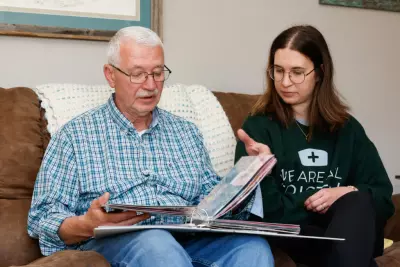
Ron insisted on sharing the letter in hopes that it might help other health care workers who are struggling. And it’s having an impact — he read a note from a woman in Calgary thanking him for sharing Tristin’s letter.
In addition, Ron and his daughters have thrown their weight behind legislation to improve working conditions for nurses in Ohio. That legislation, HB 285, includes a loan to grant program to help nurses with student loans, but the core policy change would establish nurse-to-patient ratios. Nurses argue those minimum staffing provisions are critical to delivering care and fighting burnout.
Ron described Tristin complaining about not getting breaks at her hospital in Ohio. “If you want to eat something,” he recalled her saying, “you got to grab a sandwich while you’re going to the bathroom.” Not long after she passed, he added, they got a letter from a law firm looking for clients in a wage theft lawsuit against the hospital.
In contrast, he said, Tristin was much happier during a brief stint working as a travel nurse in Sacramento. California is one of just two states to explicitly mandate nurse-to-patient ratios in state law.
“She did like better out there because they have the mandated ratios in California,” Ron explained.
“She goes, Dad, I get my breaks.”
Holding pattern
Last September, state Reps. Haraz Ghanbari, R-Perrysburg, and Elgin Rogers, D-Toledo, held a press conference to introduce their bill. Rogers described it as a “pro-patient” piece of legislation. “We’re all just one slip or fall away from needing a good quality nurse,” he added.
Seven months later, their bill still hasn’t gotten a hearing.
Last week, the Ohio Nurses Association brought about 100 nurses to the Statehouse to put their agenda before lawmakers — HB 285 was at the top of their list. House Speaker Jason Stephens and Minority Leader Allison Russo both expressed willingness to see the idea get hashed out in committee. Stephens compared the idea of staffing mandates to restrictions on how long truckers can remain behind the wheel.
“I think it’s important that we take a look at that to make sure that we have not only a qualified workforce, but a workforce that is well rested and they’re able to do their work,” he said.
So what’s the hold up?
“Anytime nurse staffing legislation is brought up anywhere around the country, including in the state of Ohio,” Russo explained, “You’re going to get a big backlash — especially from the hospitals.”
In a written statement, the Ohio Hospital Association elaborated on its opposition.
“Mandated approaches to nurse staffing limit innovation, reduce the flexibility needed to respond to patients’ changing care needs and increase stress on a health care system already facing an escalating workforce shortage,” the OHA wrote.
The group argued state law already requires hospitals to develop staffing plans with input from nurses among other caregivers. Nursing care committees review the staffing plan regularly, and it’s available as a public record.
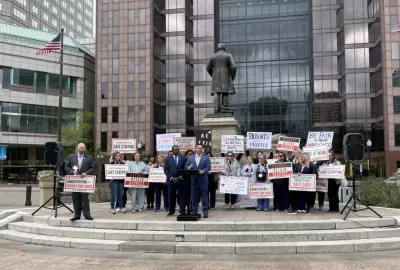
The problem, Catharyne Henderson explains, is those plans aren’t binding. She’s a staff nurse at the James Cancer Hospital at Ohio State Wexner Medical Center and chairs the Ohio Nurses Association Health Policy Council. In addition to developing that staffing plan, nurses at her hospital were able to work it into their union contract.
“And it’s still being violated,” she said. “So we have to have something that actually enforces the standards for these hospitals. Because it’s one thing to have it there (but) if they violate it every day, then that still is not getting patients care, and that’s what this is about.”
In addition to the toll nurses’ mental health, she argued, the consequences of a workforce stretched too thin show up in more visible ways, too. Patients get less attention and basic care, like help with brushing teeth or going to the bathroom. Interactions get rushed and mistakes become more common. “Those subtle changes turn into the big changes,” Henderson described.
Russo argued there’s a way to reach a compromise between nurses and hospitals.
“But that’s not going to happen if this bill doesn’t at least get some hearings,” she said.
Addressing the nurses, Rep. Ghanbari acknowledged the “arduous” process of advancing legislation. “We’ve been navigating a little bit of the proverbial minefields, if you will,” Ghanbari said, but insisted the bill is “in full motion forward.”
“He asked you to bear with us,” Rogers chimed in, “But I want to ask you to fight like hell.”
Ghanbari suggested the measure would be coming up “probably in the next week or so.” The Health Provider Services Committee which will hear the bill isn’t meeting at all this week.
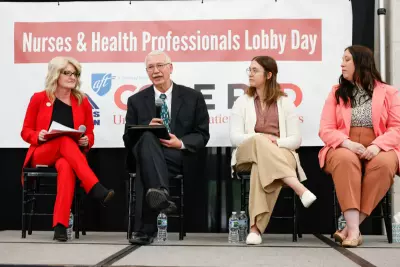
The Smiths go to the Statehouse
Ron Smith offered a blunt assessment of the Ohio Hospital Association’s statement in opposition to the legislation.
“Bulls—,” he said.
“And I’m gonna clue you in on a secret,” he added, “There’s no nursing shortage. There’s a reason why nurses are not working in hospitals, and the reason is the treatment that they get.”
Right now, there are thousands of open nursing positions in Ohio, but the 2022 National Nursing Workforce Survey depicts a profession that is beginning to rebound. Nurses are younger and more diverse, and the share of license-holders employed in the profession is up.

“Despite recent concerns about nurses leaving the profession,” the study states, “a larger proportion is now practicing in nursing roles than in previous years.” That said, the biennial study contends COVID-19 is still reverberating through the workforce. The share of nurses who report planning to retire within five years has risen compared to 2020, and many described mental and emotional challenges.
“The majority of nurses reported feeling emotionally drained from work, used up at the end of their workday, and fatigued when they woke up,” the study states. “A considerable proportion also reported feeling at the end of their rope and burned out from work. The toll of COVID-19 on nurses requires urgent attention.”
Smith and his daughters Sarah and Daye came to the Ohio Nurses event at the statehouse to speak about Tristin’s experience and offer support for nurse staffing legislation.
“We have to force their hand,” Sarah said. “Plain and simple. There is no other way to do it. People will not react unless you become that annoying sibling — ‘excuse me, excuse me, excuse me, excuse me’ — and you don’t stop until you get what you want.”
In addition to joining ONA’s event, the Smiths are hosting a rally of their own. On May 10, they’ll be demonstrating outside the Statehouse to raise awareness about Tristin’s story and to push for HB 285.
Still, they recognize they have their work cut for them. In each of the past three legislative sessions, lawmakers have proposed nurse staffing ratio legislation. And in each of the past three legislative sessions it hasn’t gotten a vote.
“You know, I kind of understand it,” Sarah said. “And here’s why — anyone that works in healthcare, knows what’s going on. The thing is, if you don’t work or know people in healthcare, and it doesn’t affect you, why do you care?”
“And so now that it’s kind of starting to gain traction it’s like, how do we help others understand the importance of it?” she added.
“To me, it’s like, it does affect everyone,” Daye said. “It affects anyone who has ever went to get medical care.”
The 988 Suicide and Crisis Lifeline is a hotline for individuals in crisis or for those looking to help someone else. You can reach them on the phone at 988 to speak with a trained listener or visit 988lifeline.org for crisis chat services. Help is also available through The Crisis Text Line. To text with a trained helper, text SAVE to 741741. It is free, available 24/7, and confidential.
Follow OCJ Reporter Nick Evans on Twitter.
The Ohio Capital Journal is an independent, nonprofit news organization dedicated to connecting Ohioans to their state government and its impact on their lives. The Capital Journal combines Ohio state government coverage with incisive investigative journalism, reporting on the consequences of policy, political insight and principled commentary.

